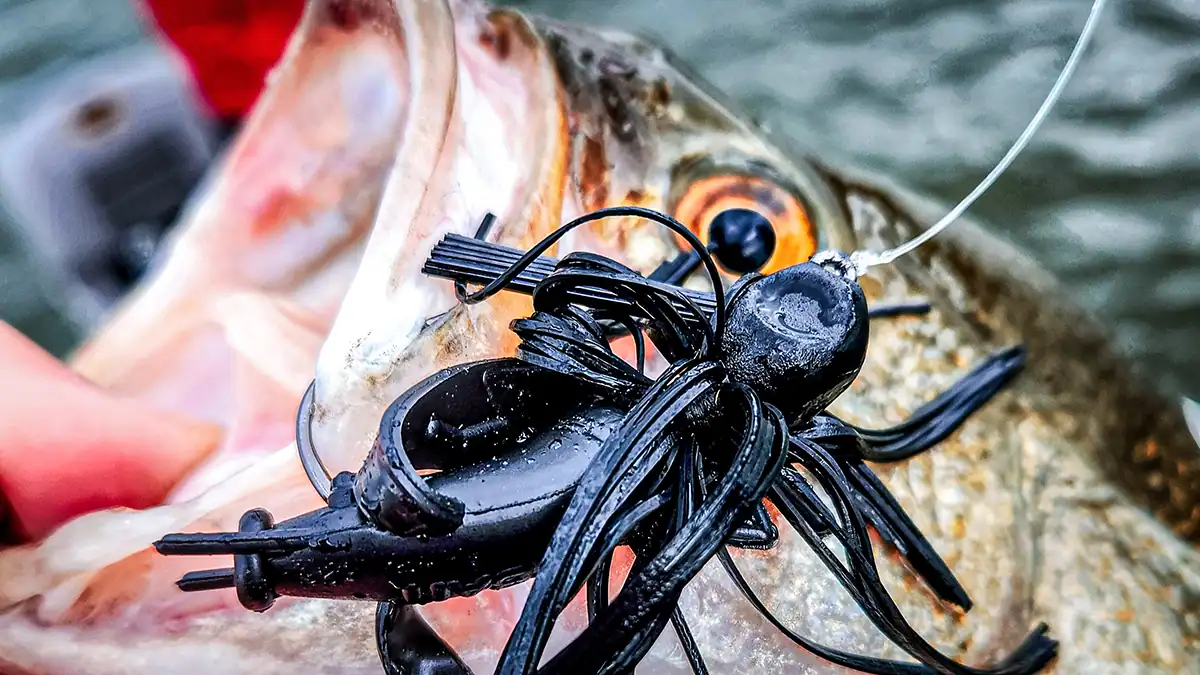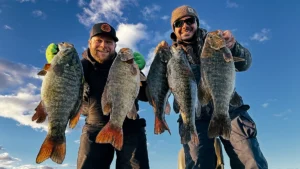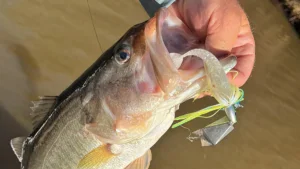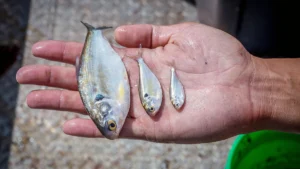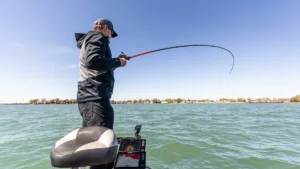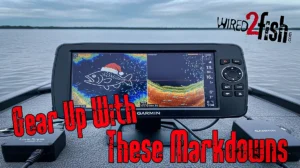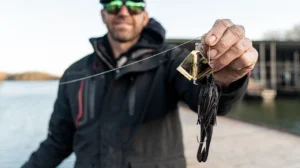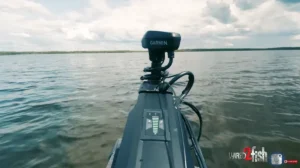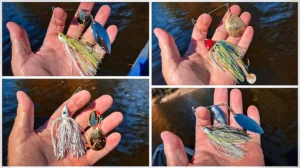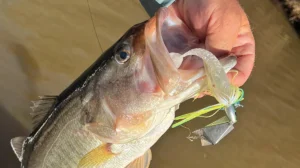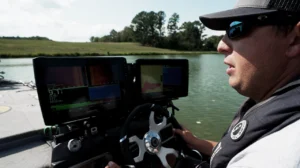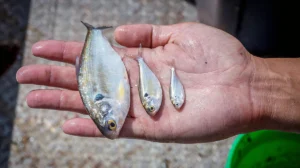Of all the lures in the world in the realm of bass fishing, there’s none more popular than a skirted jig. If you were to ask any professional bass angler on any of today’s circuits, they’d tell you a jig is their number-one fish-catching lure in their boat. It has a record of putting both numbers and big fish in the boat year after year. It’s a lure that has accounted for more fish caught than any other lure on the market today, and for good reason — they flat-out work.
Whether the times are tough and you’re looking for a bite, or it’s on fire and you love feeling that “tick” as they slurp it down, you can always count on a jig to get the job done.
But what exactly is a jig? What does it imitate? How do you work it correctly? How many different types of jigs are there? A lot of anglers are intimidated by this lure, because it seems so simple and easy to throw, but if not worked correctly, it won’t get bit. It’s all about figuring out the sweet spot.
Understanding A Jig: What Exactly Is It?
There are so many different kinds of jigs on the market today, it can be a little confusing as to what it actually is. We are talking about skirted jigs, specifically.
A skirted jig is a bait that is composed of a weighted jighead with or without a weedguard, usually a decent, stout hook, and some rubber skirt material that is either tied on to the jig or held on by a skirt collar band.
Skirted jigs come in a wide variety of shapes, sizes, head designs, hook options, and colors to best suit a particular fishing situation, and there is always some jig combination that gets bit, no matter the conditions.
Skirted jighead designs are available in many different styles, shapes, and sizes. Some are more cone-shaped to get through the grass better, and some are better suited for rocky bottoms so they won’t get hung up as much. There’s a plethora of different hook styles, as well. For the most part they are all more on the stout side, and 90% of the time, jigs are thrown on casting gear. Some finesse jigs and football jigs have lighter wire hooks for smallmouth fishing since they are much smaller in size.
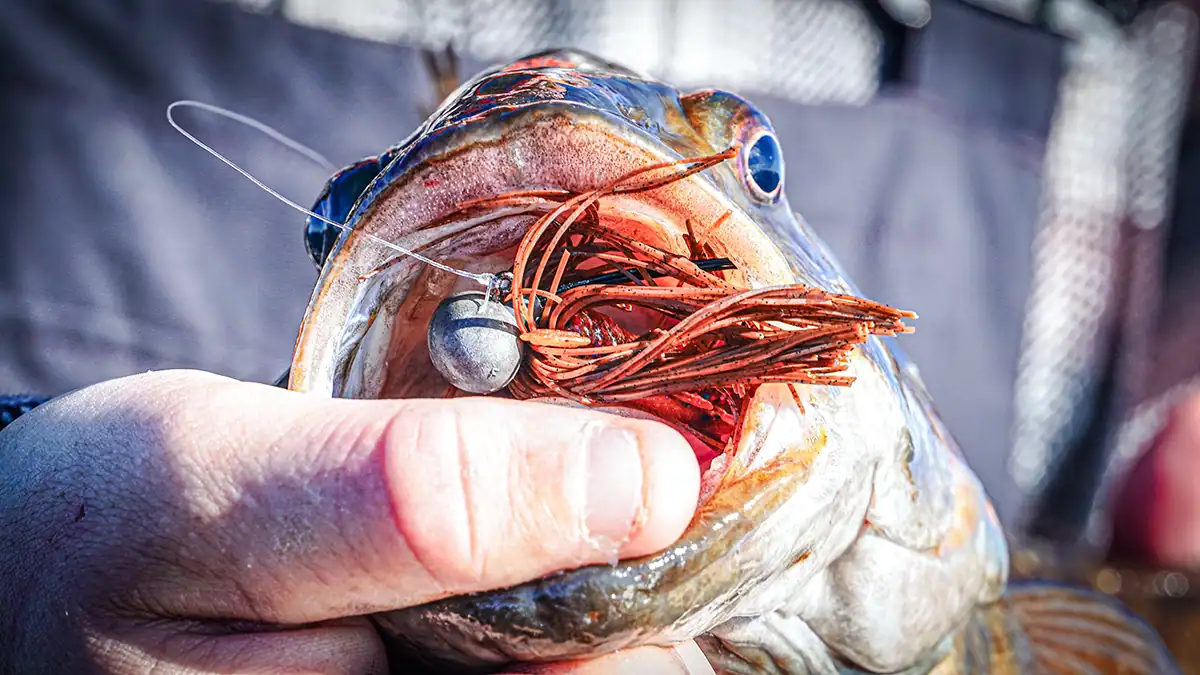
Skirt materials come in many colors to match the forage you are trying to imitate. Almost all of them are made from some kind of rubber, but there are different types of rubber, silicone, and vinyl that produce different actions. The most popular is silicone rubber, which is extremely durable. Textured silicone gives off most of a lifelike look, especially when you’re trying to imitate baitfish. There’s also round rubber, which is an excellent crayfish imitator as it flares out a lot more than other skirting materials.
A rubber collar is often used to attach the skirt to the jig, but they aren’t a perfect attachment solution. They are subject to dry-rot over time and will fall apart after a while and the skirt can slide and slip out of position. For more durable skirted jigs, look for options with the skirt hand-tied to the jighead. Hand-tied skirts always stay in place and never slip.
Different Types of Jigs and What They Imitate
If you head down to your local Bass Pro Shops or tackle shop and head to the jig aisle, you may think they all look the same and can be used to imitate the same thing. That couldn’t be further from the truth. Every different kind of jig imitates something different in the water. Many are designed to look like crayfish on the bottom when paired with craw-style trailers. Some, when paired with small paddle tail swimbaits or a ned bait, are made to imitate gobies on the Great Lakes. Others can be huge, with big hooks intended to be paired with a big trailer to look like baitfish or bluegills.
This guide will help you understand what you can expect to find at the tackle shop, what the different jig styles are, and how they should be used.
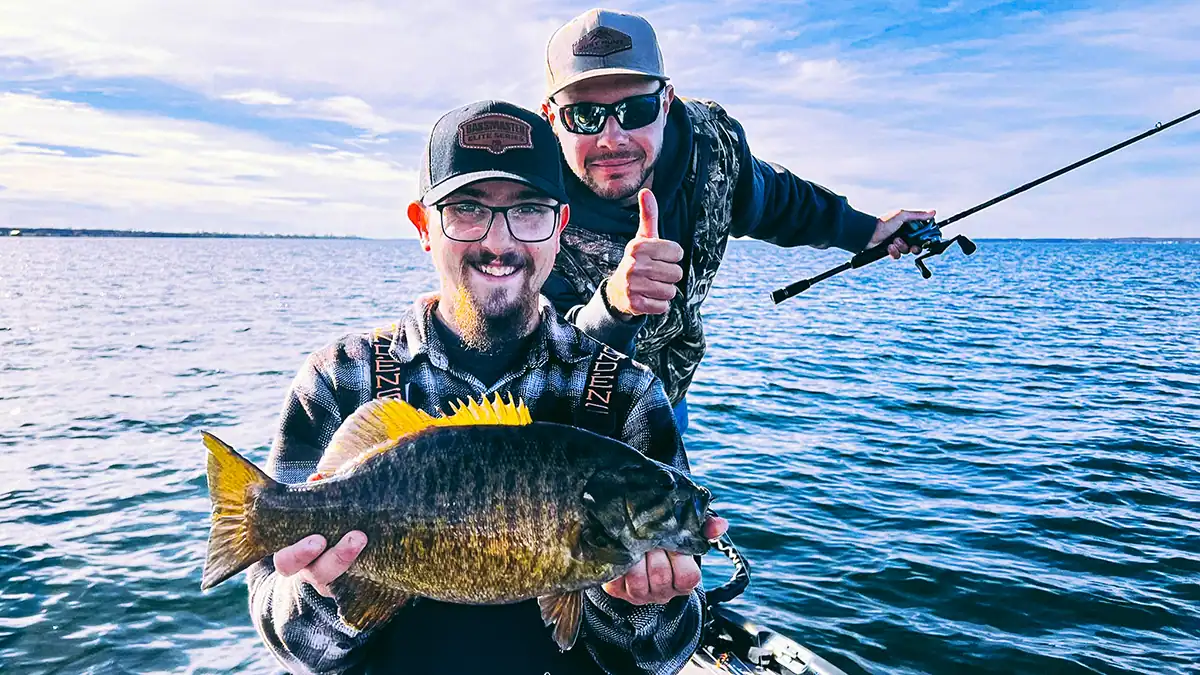
Casting Jigs
Arguably, the most popular style of jig on the market, and for good reason. Out of all the different jig styles, it’s definitely the most versatile, because with different aesthetics and presentations, it can be made to look like a wide variety of prey.
As the name suggests, casting jigs are used for casting around various pieces of structure. It can be swam, hopped, skipped, flipped, or dragged across any piece of structure. This is one jig I have tied on at all times, from ice-out to ice-in. If I had to pick one, specifically, it would be a Keitech Model 1 Casting Jig as its perfect for every single scenario you could face while jig fishing.
Football Jigs
More commonly used by smallmouth guys or Tennessee river ledge fisherman, the football jig is the best head designed jig to drag through rocks, ledges and hard structure. Its football shaped head design allows the bait to wiggle its way through the rocks with ease. While some football jigs have larger hooks for big largemouth, a majority have compact designs and smaller hooks that are specifically built for big northern smallmouth or pressured bass.
Where I fish in New York, a football jig, especially the Beast Coast Fishing OW Sniper, accounts for a good number of my biggest catches of the year for both species. The Sniper is mainly meant to imitate either gobies or smaller crayfish slowly moving along the bottom.
Finesse Jigs
When the bite is tough and a normal-size jig isn’t working, downsizing to a finesse jig can make a big difference. They often have smaller, light-wire hooks, a ball-head design, and interesting skirt cuts to make it a more finesse presentation.
I’ve found that these little jigs can be killer during the post-spawn period, when bites are hard to come by. While you can still use most finesse jigs on casting gear, sometimes, with lighter baits, spinning gear is needed.
Swim Jigs
Sounds pretty self explanatory right? And it genuinely is. The swim jig is one of those standard “chuck and wind” baits that is meant to be horizontally swam through the water column. When paired with a smaller swimbait or grub-style bait, it can imitate a variety of baitfish.
When bass are schooling around weed edges and you need a bait that will get through the vegetation, a swim jig is perfect for the job. Swim jigs have a cone shaped head paired with a weed guard to help “swim” through the vegetation and not hook on to any of it.
For me, you can’t beat the size and profile of a Dirty Jigs Swim Jig. Its profile and size make it perfect for coming through vegetation as clean as possible.
Flipping/Pitching Jigs
While some anglers use a Texas rig for most of their flipping and pitching needs, a jig can make a great presentation as well. What separates a flipping jig from a normal casting jig is the pointed head to get through cover better, and a stouter hook that doesn’t bend out on the hookset. Everything is beefier and stronger on a flipping jig. After all, it’s for heavy cover “combat” fishing. Often the weights are heavier than a normal jig to help punch through the cover and create a reaction strike.
Micro Jigs
While most anglers think that finesse jigs are about as small as they go, they are wrong. Originating in Japan, micro jigs have been an up and coming tactic, especially on waters with high fishing pressure. It’s one of those techniques where you need spinning or BFS gear to present the bait in an appropriate manner.
When presented in the right way, it can pay off with some huge bass. Most of these jigs, like finesse jigs, have special cuts in the rubber making it look different in the water, and most rarely go above 3/32 ounce — so we are talking really small!

Jig Fishing Techniques and Tactics: How to Choose the Right Jig for the Job
A jig can be used in a variety of different circumstances with one common goal in mind, all jigs should be fished around some type of underwater or visible structure. As mentioned above, not all jigs work the same around every piece of cover in the lake, so it’s important to understand how each one is used to put more fish in the boat for you.
Shallows with Lots of Structure
When you’re looking to fish shallow water and cover lots of structure with a horizontal presentation, that’s when a swim jig shines. In many cases, I fish a swim jig in the same spots I would fish a spinnerbait and a chatterbait.
Think of a swim jig as both of those baits, without as much vibration. It’s a simple cast and retrieve kind of bait, with most of your casts coming just from a simple straight retrieve. You can pop it or twitch it to give some extra motions, but you’re going to want to let your trailer do all the work. My top swim jig trailers are a 4.3” Keitech Fat Swing Impact or a Strike King Menace Grub. Both have incredible action to draw fish in.
Deep Rocks
If you’re fishing around very deep rock or boulders, a football jig is hard to beat. When fishing something like a Keitech Model 2 Football Jig, you’ll want to make a long cast and let that bait hit the bottom. Then, you can hop it around, but I’ve found that the best action is just simply dragging it along the bottom; less is more. Dragging it ever so slowly to feel every single rock and boulder along the bottom.
Nine times out of 10 your bite will come when the bait is popped off a rock as many bass will be following it on the drag in. Trailers can be varied as to what you are trying to imitate in the lake. The Berkley Maxxscent Lil’ Trooper and Lil’ General are perfect baits to pair with football jig to imitate a wide variety of forage in many different water bodies across the nation.
Isolated Structure
When the bite is tough, especially in shallow circumstances around isolated rock or wood, that’s when finesse and micro jigs shine. In many cases, downsizing your baits could mean more bites which means more fish in the boat.
For fishing these styles of jigs, I do a combination of things: I combine the drag of a football jig with the hop of a ned rig. Especially on spinning tackle and lighter line, you can feel everything that the bait is doing on the bottom. Trailers are necessary to add that little bit of action to the bait, and that’s where the Great Lakes Finesse Flat Cat and Snack Craw come into play. The action that these little baits create is perfect for finesse applications.

Anything Else
For everything else in between, a casting jig should have you covered. It is one of the most versatile jigs for covering a vast variety of techniques. My two favorites are to cast it along grass lines and drag it back to the boat, or to skip boat docks and overhanging cover with it.
Having a bulkier trailer is important, especially when skipping docks, mainly because the bait needs a flatter shape to skip better. The best trailer for that would be a Net Bait Paca Chunk, which has been my go to casting-jig trailer for years. They are sturdy, inexpensive, and flat out get bit when paired with a casting jig.
Be Sure to Have the Right Gear
When jig fishing, it’s important to have the appropriate equipment to not only land the fish, but effectively feel every little bite. For a beginner just looking to start out, a standard 7-foot, heavy-action casting rod paired with a high-gear-ratio casting reel loaded with 15-pound fluorocarbon line will do you just fine. You can’t go wrong with the new G. Loomis GCX 854C JWR which is a 7’1” heavy-action rod with a fast tip paired with a Shimano Curado M, which has a gear ratio of 8.5:1. This is my exact all around jig combo that I use on a day to day basis. The sensitivity on this rod is superb to feel those light biting bass as well as getting them out of the cover quick enough with a fast-gear-ratio reel.
For swim jigs, I prefer the same setup that I use for a spinnerbait and a chatterbait, which is a 7’3” medium-heavy action rod with a moderate-fast tip. Seeing as how a swim jig is almost a reaction bait moving horizontally, you want to still be able to get a good hook in the fish as well as keep them pinned. The moderate-fast action will also absorb the shock of the bite as bass are ferocious when they hit a swim jig.
Lastly, for finesse and micro jigs, this is where spinning gear comes into play. Great Lakes Finesse came out with a perfect rod for finesse application like small jigs — its killer. Their new Finesse CX line of rods in the 7’4” medium-light action is easily one of the most light, sensitive, and strong spinning rods out on the market today.
I fish a lot of my smaller jigs on spinning gear to get the casting distance as well as better sensitivity. The Finesse CX rods do just that, as well as having a superb backbone for a great light jig rod. Pair it with a 3000 size spinning reel and ten pound braided line and you’re set for fish catching success!
Common Mistakes and Tips
In jig fishing, there are a few mistakes you can make on the water that will cost you some fish. But if fished correctly, you can catch way more fish than all your buddies.
DO NOT OVERWORK THE BAIT! I can’t stress this enough. When I’m out on the water watching guys fish near me, they are hopping a jig like it’s their job to give it so much action, then they wonder why my clients and myself are putting way more fish in the boat. Remember, when fishing a jig, especially on the bottom, less is always more. As a rule of thumb, the slower you go, the more bites you will get.
Now, are there times on the water where you can hop the bait like a mad man and catch fish? Absolutely! But does that happen all the time? Not at all. Remember, if you think you’re fishing, slow down!
Also, always have some sort of a trailer on your jigs; it’s what adds action to the bait. Without a trailer, a jig doesn’t look like anything natural in the water. Having the appropriate trailer for the size of the jig you’re using will help increase bites.
Lastly, always check your line while jig fishing. Since it’s a perfect bait to use around structure, your line will be constantly rubbing up against different things on the bottom. Especially with many invasive species around throughout the country, like zebra mussels, line abrasion from the bottom is more common than ever. Always take the time to re-tie or it could cost you the biggest fish of your life.
—
Fishing a skirted jig can be one of the most rewarding ways to fish. It’s a bait that has the power to help you catch the biggest fish of your life. If it wasn’t for a skirted jig, I probably wouldn’t have caught an eight pound bass in New York. Take these tips into consideration and you might be holding a new personal best for yourself.
